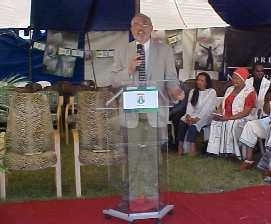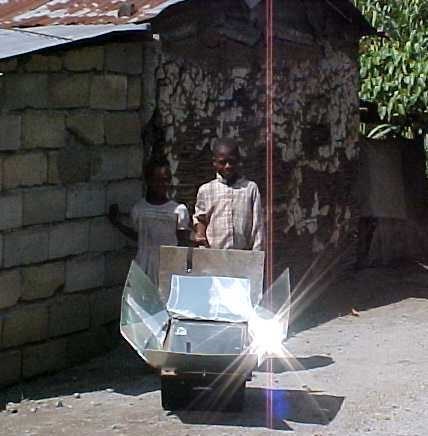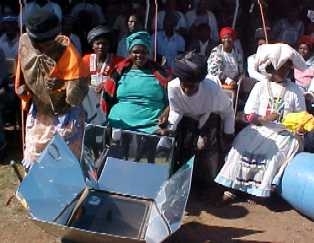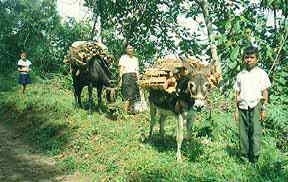 |
| Paul Munsen speaking in South Africa (sunoven.com) |
If Paul Munsen had the attention of the world for 10 minutes, he would bake. Well, bake and talk. He would let people see how simple it is to cook with a solar oven. And he would share the global benefits of using the best renewable resource…the sun…to cook. We would learn that when a family of 8 uses a global sun oven, over 4 tons of wood a year is saved. Plus, 5.2 tons of emissions will NOT be released into the atmosphere. Women and children will not have to risk their lives foraging for wood or inhale the equivalent of 2 packs of cigarettes a day by cooking over a fire. Munsen could actually talk for days about this path he has found himself on, 8 years after giving a little marketing advice to a fellow Rotarian, that changed his life forever. After seeing the need and worthiness of this endeavor, he took over the reins from the original sun oven inventor, Tom Burns.
Paul Munsen is president of Sun Ovens International, an Illinois-based company that manufactures solar ovens for use in 126 countries, from Haiti to Ghana, Afghanistan to Sri Lanka, North America to North Korea. He has had to take out a mortgage on his own home to keep the business going, but could never abandon ship now. 2 billion families on the planet depend on wood, charcoal and other fuels to cook their food. According to Population Action International, nearly one in three people live in countries considered to have critically low levels of forest cover. Each minute, there are 200 more people on the planet and 50 acres less forest. Paul says, "By harnessing the sun's rays, our ovens offer a free, reliable, nonpolluting energy source."
 |
| Kids in Haiti (sunoven.com) |
MY HERO caught up to Mr. Munsen as he was preparing a large shipment of ovens to be sent to many of the destroyed villages in the tsunami devastated areas of Sri Lanka.
So, how does a solar oven work?
According to Mr. Munsen, "The short rays of the sun shine into the box (solar oven), and they convert to long rays that can't escape. It heats up the box. So, a solar oven is really just a very well insulated box. The huge Villager Oven and the much smaller family model (Global Sun Oven) work the same way. Sun ovens operate on a very simple principle called the greenhouse affect. Solar ovens can also be used to purify water…a very big concern in a lot of refugee camps and parts of Africa that do not have access to clean drinking water. In developing countries we send a water pasteurizing indicator…and it can tell when water has been pasteurized. Water is pasteurized when it has been above 160 degrees F for 6 minutes. That will kill all the bacteria. Boiling is 212 degrees F…so one doesn't need to boil it. And it's 4 times faster to pasteurize…so you save on energy."
What is the wildest thing you have ever cooked in a solar oven? Or heard of being cooked in one?
"One time to prove a point we cooked an entire goat. It was for a fundraiser in Wisconsin by a farmer that raised goats and was very involved in sending solar ovens to Haiti. We cooked a goat and invited 750 people to come and sample it. It took 2 1/2 hours in a large villager oven. Accompanied by baked beans and bread cooked in several global sun ovens. The ovens are used in many different countries all over the world, so any dish native to that country can be cooked."
 |
| Women watch the oven at work (sunoven.com) |
How does the food stay so moist and tender? Is it true food won't burn?
"It stays moist and tender because there is no movement of air and the entire chamber heats evenly. The complex carbohydrate breaks down slowly, so there is no drying and that allows the food to stay tender. Reason it doesn't burn is that the entire chamber is the same temperature…the food, pot and air around the pot. The soup on a stove will scorch underneath if you don't keep stirring because the heat is coming from directly underneath."
Where do most of your ovens go? Who buys them?
"Most go into developing countries. Haiti has the most followed by Ghana. Each of these countries now has their own solar oven factories. In Ghana it's mostly people that buy them. In Haiti it's different relief agencies, development agencies, ngo's and fundraisers like Slater's homeschooling group."
It seems like such a logical choice…solar ovens in developing countries…no infrastructure is needed…anyone can use one…so why the resistance?
"Primary resistance is more cultural than technical. Women have cooked the same way for generations. Most food in Africa is corn maize-based and the women will tell you that the only way to cook it is to stir often and add water slowly. Once you start cooking with a solar oven, you can't open it. Convincing them to change is the major challenge. In the west we overcome that by using recipes. Even though it's much easier to put everything in the pot and come back when done, it's hard to change generations of passed down protocol."
 |
| Children getting wood for cooking (sunoven.com) |
How does using solar ovens help with the environment? With sustainability?
"When a solar oven is used in a developing country it has a huge impact on the environment. One of the large Villager Ovens, when used to replace a wood fire bakery, saves 150 tons of wood a year…which equals 277 tons of CO2 emissions…greenhouse gases. In Africa, on a household level, each person uses about a 1/2 a metric ton of wood a year for cooking and the smaller global oven is able to replace approximately 70% of that. When a family of 8 uses a global sun oven, over 4 tons of wood a year is saved. And 5.2 tons of emissions a year are not released into the atmosphere.
As far as sustainablity…The sun is always there but the availability of fuels is not always there and consistent. The ovens are designed to be maintenance free for 20 years. Leaving the trees standing has a tremendous effect on oxygen which reflects on rainfall. Ethiopia used to be a tropical paradise and now much of the rain forest has become desert and there are major droughts. The whole cycle shifts when so many trees are cut down. When a woman cooks over an open fire it's like smoking 2-3 packs a day. Often the women cook with their babies strapped around them, so the babies breathe that same smoke. Infectious lung disease is the 2nd highest rate of disease, after AIDS, and eyesight is also being affected at an alarming rate."
In this day and age more and more people realize it would be a good idea to scale back our dependency on foreign oil. So why is it so hard to make the leap to solar and wind power?
"I think the main reason is awareness. When people become aware of it they gravitate towards it. The benefits of saving energy with solar cooking are very high in the summer months when air conditioning has to be turned on, especially when using your oven. Most people don't even know the concept exists. The problem with solar and wind is that there is a longer time to get a payback, but once it's paid back there are no more costs to the consumer."
You have seen some pretty devastating sights of human suffering and hunger. How do you keep going?
"Well, I guess in some ways when you see you can make a difference it keeps you going. Helping one person at a time accomplishes something. A lot of times it is so frustrating you want to look away. Now, because of inflation, the price of charcoal has gone up so much in Haiti that it's becoming very hard to also buy fuel. People who were cooking with propane are now going back to wood. Each day they have to make a decision between food and buying the fuel to cook it. We are trying to make new ways to help people pay for the ovens."
Have you thought about approaching the Department of Education or the Environment and pairing schools in the US with schools in other countrie, so that the schools in the US could adopt a school, say in Sri Lanka or Haiti, and raise money to send the ovens to them?
"We have done that to a small degree with people like Rowena Gerber and through the iEARN program, your homeschoolers and the Sunday School programs. I'll be going to Sri Lanka this fall and there is a Rotary program that is sending a lot of ovens over there."
What gives you joy?
"The single biggest thing that gives me joy is my relationship with God through Jesus Christ. Also, everytime I see a shipment of Solar Ovens leave here I get excited."
What makes you laugh?
"A lot of things. I'm generally a happy person."
How can kids get involved with your vision?
"There are many ways. We have one program, for example in Angola, where children, groups of Sunday School classes, can adopt a mother. It's called Share Circle. With this program, a single mother is adopted and they then are able to receive a solar oven. It takes about 6 months and the sponsoring group gets a picture and follow-up info about the mother and her family."(Go to the links below to get involved with your school or as individuals.)
Paul Munsen continues to share his Sun Oven vision with the world. He addressed the United Nations on the environmental impact of using solar ovens and worked with the U.S. Department of Commerce to find a Haitian Partner to manufacture and market the solar ovens in that country. Along with Teacher Hero Rowena Gerber and her students, he baked for the World Food Program on top of their building in Washington, D.C. He cooked for and broke bread with Nelson Mandela in South Africa. But what really keeps him going, are the millions of women and children all over the world that can have better, healthier lives with the help of a solar oven. Such a simple solution to such a large problem. We can all help by going to the links below and joining Mr. Munsen and his partners on their quest to provide solar ovens to those in need.
Page created on 8/17/2014 10:28:32 AM
Last edited 1/9/2017 11:02:29 PM
What can I cook in a GLOBAL SUN OVEN®?
Anything you can cook in a conventional electric or gas oven can be cooked in a GLOBAL SUN OVEN®. You can bake, boil and steam using any of your favorite recipes.
What is the cooking temperature range?
The GLOBAL SUN OVEN® will reach temperatures of 360 to 400 degrees Fahrenheit. The oven will generally reach its maximum temperature as it is being preheated. The temperature will drop when food is placed in the chamber.
Will food prepared in a GLOBAL SUN OVEN® taste the same as food prepared in my conventional oven?
The food tastes much better! Solar cooking allows many of the natural flavors of food, which get baked out in conventional ovens, to remain. The slow, even rise in temperatures in a GLOBAL SUN OVEN® gives the complex carbohydrates time to break down into simple sugars allowing subtle natural flavors to emerge. Sun baked foods stay moist, the natural internal juices do not bake out, resulting in a superior, moist taste and much less shrinkage.
How long does it take?
Cooking times are close to the same as those in a conventional oven. Because the sun is often trying to run away and hide behind clouds, cooking times can vary. At times it may take a little longer. The factors that affect the cooking time are: the quality of the sunlight at the time you are cooking, the types and quantities of the food being cooked, and how often the oven is being refocused.
Does a GLOBAL SUN OVEN® require special pots and pans?
No, but dark, thin-walled pots with lids work best. Dark pots change the light from the sun into heat energy. Lids are important because they hold steam in the pot. If a lid is not used, the steam will dissipate much of the heat. Shiny aluminum pots and pans cause light to be reflected out thereby reducing the oven's temperature. Glass casserole dishes with lids also work well. For baking cakes, breads, cookies, and pies, dark cookie sheets and baking tins work best.
Does food need to be stirred?
No. Stirring to prevent scorching is not required when cooking in a GLOBAL SUN OVEN® due to the fact that there are no hot spots. The temperature of the food rises evenly. It is almost impossible to burn food in a GLOBAL SUN OVEN®.
How difficult is it to focus a GLOBAL SUN OVEN®?
Focusing a GLOBAL SUN OVEN® is very easy. All that is required is to watch the shadows created by the oven. When the shadows are even on all sides, the cooker is directly focused. The built-in leveling leg on the back of the oven allows for easy tracking.
How often must a GLOBAL SUN OVEN® be refocused?
The need to refocus depends a great deal on what you are cooking, the time of day, and the temperature you wish to maintain. A good rule of thumb is to plan to readjust every 30 minutes to maintain maximum heat. At noon the sun is high in the sky and moves quickly past the maximum focus point, creating the need to refocus more often. Later in the day you will not need to refocus as often. The GLOBAL SUN OVEN® is equipped with a built in Levelator, which keeps food level and avoids spills while being refocused.
Many meals can be cooked without refocusing. GLOBAL SUN OVEN® users often will put their ovens outside, focused for the mid-day sun, with their dinner in it when they leave for work in the morning. As the sun moves overhead, the temperature in the GLOBAL SUN OVEN® chamber slowly rises to a cooking level. As the sun passes, the food is kept warm and when they return from work they have a warm, sun-cooked dinner.
(Keep in mind food will not burn in a GLOBAL SUN OVEN® and that the chamber is extremely well insulated, allowing food to stay warm for hours.)
With the GLOBAL SUN OVEN® getting so hot, what is the risk of getting burned when using it?
The only parts that get hot are the oven chamber, the cooking pan, and the glass door. Proper care must be taken to use hot pads when opening the door and removing food. The entire exterior of the oven, including the reflectors, remains safe to touch.
How long will a GLOBAL SUN OVEN® last?
The estimated life of a GLOBAL SUN OVEN® is 20 + years. With proper care it should last a lifetime.
Do I need special recipes to cook in a GLOBAL SUN OVEN®?
The GLOBAL SUN OVEN® reaches temperatures comparable to that of conventional ovens, therefore no special recipes are required. A good rule of thumb is to add 10 to 15 minutes of cooking time for each time the oven door is opened.
What are the dimensions of the GLOBAL SUN OVEN®?
The size of the GLOBAL SUN OVEN® is 19'' x 19'' with an average depth of 11''. The total weight is only 21 pounds.
Can I use a GLOBAL SUN OVEN® in the winter?
Yes. The most important factor in using a GLOBAL SUN OVEN® is the brightness of the day, NOT the outside air temperature. Often, a 40-degree, clear, low-humidity day will allow food to cook faster than a 100-degree day with high humidity. The GLOBAL SUN OVEN® has been used very successfully at the base camp of a Mt. Everest expedition where the temperatures are often well below zero. There are, however, more cooking hours available in the summer than in the winter. In the early summer, it is not unusual to cook from 8:00 AM to 6:00 PM, whereas during the early winter, effective cooking is limited from 10:00 AM to 2:00 PM.
How does it work?
The black surfaces on the inside of the oven capture and transform the sun's energy into a form that cannot escape the oven chamber. When a GLOBAL SUN OVEN® is focused in the sun, the interior of the oven is heated by the sun's energy. Direct and reflected sunlight enters the oven chamber through the glass door. It then turns to heat energy when it is absorbed by the black inner-shell and Levelator. This heat input causes the temperature inside the oven to rise until the heat loss of the oven is equal to the solar heat gain. The light energy absorbed by dark pots and the oven's dark interior is converted into longer wavelength heat energy. Most of this longer wavelength radiant energy cannot pass back out through the glass, ensuring more efficient cooking.
Are GLOBAL SUN OVENS® used in countries outside of the United States?
Yes. Currently they are being used in 126 countries around the world. Many of these countries purchase unassembled GLOBAL SUN OVENS® and complete the final assembly on location. This reduces the overall cost of the ovens and shipping while creating jobs locally. The demands of massive population growth, and inefficient conversion of wood to charcoal, have outstripped the Third World's forests ability to regenerate. The ecological effect of wood fuel is burdensome and has a far-reaching negative global impact. These global trends will lead to environmental destabilization, deforestation and global warming. Science strongly supports the fact that deforestation for agricultural and fuel use is changing weather patterns, causing soil erosion, and depleting plant and animal life. GLOBAL SUN OVENS® offer a powerful solution to the effects of deforestation, and can have an enormous positive impact on the everyday life of millions of people in underdeveloped countries by improving their nutrition, health, and quality of life.
